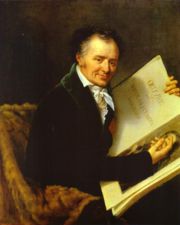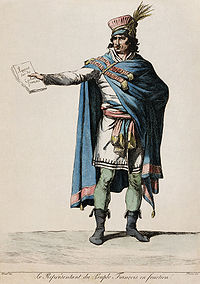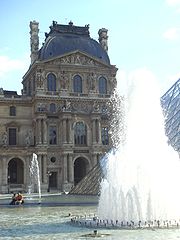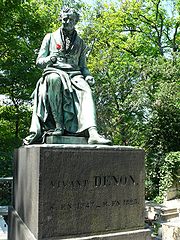
Dominique Vivant
Encyclopedia
Dominique Vivant, Baron de Denon (4 January 1747–27 April 1825) was a French
artist
, writer
, diplomat
, author
, and archaeologist. He was appointed first director of the Louvre Museum by Napoleon after the Egyptian campaign of 1798-1801.
 Born at Givry, Saône-et-Loire
Born at Givry, Saône-et-Loire
, Denon was sent to Paris
to study law, but he showed a decided preference for art and literature, and soon gave up his profession. In his twenty-third year he produced a comedy, Le Bon Pré, which obtained a succès d'estime, as he had already won a position in society by his agreeable manners and exceptional conversational powers. He became a favorite of Louis XV
, who entrusted him with the collection and arrangement of a cabinet of medals and antique gems for Madame de Pompadour
, and subsequently appointed him attaché
to the French embassy at St. Petersburg.
 On the accession of Louis XVI
On the accession of Louis XVI
, Denon was transferred to Sweden
; but he returned, after a brief interval, to Paris with the ambassador M. de Vergennes, who had been appointed foreign minister. In 1775 Denon was sent on a special mission to Switzerland
, and took the opportunity of visiting Voltaire
at Ferney. He made a portrait of the philosopher, which was engraved and published on his return to Paris. His next diplomatic appointment was to Naples
, where he spent seven years, first as secretary to the embassy and afterwards as chargé d'affaires
. He devoted this period to a careful study of the monuments of ancient art, collecting many specimens and making drawings of others. He also perfected himself in etching
and mezzotint
o engraving. While in Naples he met Sir William
and Lady Hamilton
and he etched Lady Hamilton 'posing'.
The death of his patron
, M. de Vergennes, in 1787, led to his recall
, and the rest of his life was given mainly to artistic pursuits. On his return to Paris he was admitted a member of the Académie de peinture et de sculpture
(1787). After a brief interval he returned to Italy, living chiefly at Venice
. He also visited Florence
and Bologna
, and afterwards went to Switzerland. While there he heard that his property had been confiscated, and his name placed on the list of the proscribed
, and with characteristic courage he resolved at once to return to Paris: his situation was critical, but he was spared, thanks to the friendship of the painter David
, who obtained for him a commission to furnish designs for republican costumes. When the Revolution
was over, Denon was one of the bands of eminent men who frequented the house of Madame de Beauharnais
. Here he met Bonaparte, to whose fortunes he wisely attached himself.
as part of the arts and literature section of the Institut d'Égypte
, and thus found the opportunity of gathering the materials for his most important literary and artistic work. He accompanied General Desaix to Upper Egypt
, and made numerous sketches of the monuments of ancient art, sometimes under the very fire of the enemy. The results were published in his Voyage dans la basse et la haute Egypte (Journey in Lower
and Upper
Egypt
), published as two volumes in 1802. The work crowned his reputation both as an archaeologist and as an artist, and sparked the Egyptian Revival in architecture and decorative arts. (See: Egyptian revival architecture
and Egyptian revival decorative arts
)
 In 1804 he was appointed by Napoleon to the important office of director-general of museums and head of the new Musée Napoléon, which he filled until the Allied occupation of Paris in 1814, when he had to retire. He was a devoted servant of Napoleon, on whose behalf he personally looted vast numbers of works of art in Italy, the Low Countries and Germany and, through agents (including Goya), in Spain, for the Musee Napoleon in Paris. Many of these remain in the Louvre, and elsewhere in France, today. In particular, Denon was one of the very first men to appreciate the importance of the Italian 'primitives'. The majority of those now in the Louvre were looted by Denon during a sweep he made through Italy in 1812. They were publicly paraded, with elephants and other wild animals, like a Roman Triumph
In 1804 he was appointed by Napoleon to the important office of director-general of museums and head of the new Musée Napoléon, which he filled until the Allied occupation of Paris in 1814, when he had to retire. He was a devoted servant of Napoleon, on whose behalf he personally looted vast numbers of works of art in Italy, the Low Countries and Germany and, through agents (including Goya), in Spain, for the Musee Napoleon in Paris. Many of these remain in the Louvre, and elsewhere in France, today. In particular, Denon was one of the very first men to appreciate the importance of the Italian 'primitives'. The majority of those now in the Louvre were looted by Denon during a sweep he made through Italy in 1812. They were publicly paraded, with elephants and other wild animals, like a Roman Triumph
, through the streets of Paris, before being deposited in the Louvre.
Denon took full opportunity, while working for Napoleon, to assemble for himself an enormous collection of paintings, drawings, prints, books, statuary and objets d'art. This collection was sold at auction over several days after Denon's death.
 After his forced retirement in 1814 he began an illustrated history of ancient and modern art, in which he had the cooperation of several skilful engravers. He died at Paris in 1825, leaving the work unfinished. It was published posthumously, with an explanatory text by Amaury Duval, under the title Monuments des arts du dessin chez les peuples tant anciens que modernes, recueillis par Vivant Denon in 1829. Denon was also the author of an erotic novel, Point de lendemain, published in 1777 (in 1812 as a separate work), and of a number of pornographic etchings.
After his forced retirement in 1814 he began an illustrated history of ancient and modern art, in which he had the cooperation of several skilful engravers. He died at Paris in 1825, leaving the work unfinished. It was published posthumously, with an explanatory text by Amaury Duval, under the title Monuments des arts du dessin chez les peuples tant anciens que modernes, recueillis par Vivant Denon in 1829. Denon was also the author of an erotic novel, Point de lendemain, published in 1777 (in 1812 as a separate work), and of a number of pornographic etchings.
has written a biographical novel of Denon's life:
France
The French Republic , The French Republic , The French Republic , (commonly known as France , is a unitary semi-presidential republic in Western Europe with several overseas territories and islands located on other continents and in the Indian, Pacific, and Atlantic oceans. Metropolitan France...
artist
Artist
An artist is a person engaged in one or more of any of a broad spectrum of activities related to creating art, practicing the arts and/or demonstrating an art. The common usage in both everyday speech and academic discourse is a practitioner in the visual arts only...
, writer
Writer
A writer is a person who produces literature, such as novels, short stories, plays, screenplays, poetry, or other literary art. Skilled writers are able to use language to portray ideas and images....
, diplomat
Diplomat
A diplomat is a person appointed by a state to conduct diplomacy with another state or international organization. The main functions of diplomats revolve around the representation and protection of the interests and nationals of the sending state, as well as the promotion of information and...
, author
Author
An author is broadly defined as "the person who originates or gives existence to anything" and that authorship determines responsibility for what is created. Narrowly defined, an author is the originator of any written work.-Legal significance:...
, and archaeologist. He was appointed first director of the Louvre Museum by Napoleon after the Egyptian campaign of 1798-1801.
Biography

Givry, Saône-et-Loire
Givry is a commune in the Saône-et-Loire department in the region of Bourgogne in eastern France.-Geography:Located from Chalon-sur-Saône , Givry is a small town, famous for its listed monuments and its wines...
, Denon was sent to Paris
Paris
Paris is the capital and largest city in France, situated on the river Seine, in northern France, at the heart of the Île-de-France region...
to study law, but he showed a decided preference for art and literature, and soon gave up his profession. In his twenty-third year he produced a comedy, Le Bon Pré, which obtained a succès d'estime, as he had already won a position in society by his agreeable manners and exceptional conversational powers. He became a favorite of Louis XV
Louis XV of France
Louis XV was a Bourbon monarch who ruled as King of France and of Navarre from 1 September 1715 until his death. He succeeded his great-grandfather at the age of five, his first cousin Philippe II, Duke of Orléans, served as Regent of the kingdom until Louis's majority in 1723...
, who entrusted him with the collection and arrangement of a cabinet of medals and antique gems for Madame de Pompadour
Madame de Pompadour
Jeanne Antoinette Poisson, Marquise de Pompadour, also known as Madame de Pompadour was a member of the French court, and was the official chief mistress of Louis XV from 1745 to her death.-Biography:...
, and subsequently appointed him attaché
Attaché
Attaché is a French term in diplomacy referring to a person who is assigned to the diplomatic or administrative staff of a higher placed person or another service or agency...
to the French embassy at St. Petersburg.
Diplomatic career

Louis XVI of France
Louis XVI was a Bourbon monarch who ruled as King of France and Navarre until 1791, and then as King of the French from 1791 to 1792, before being executed in 1793....
, Denon was transferred to Sweden
Sweden
Sweden , officially the Kingdom of Sweden , is a Nordic country on the Scandinavian Peninsula in Northern Europe. Sweden borders with Norway and Finland and is connected to Denmark by a bridge-tunnel across the Öresund....
; but he returned, after a brief interval, to Paris with the ambassador M. de Vergennes, who had been appointed foreign minister. In 1775 Denon was sent on a special mission to Switzerland
Switzerland
Switzerland name of one of the Swiss cantons. ; ; ; or ), in its full name the Swiss Confederation , is a federal republic consisting of 26 cantons, with Bern as the seat of the federal authorities. The country is situated in Western Europe,Or Central Europe depending on the definition....
, and took the opportunity of visiting Voltaire
Voltaire
François-Marie Arouet , better known by the pen name Voltaire , was a French Enlightenment writer, historian and philosopher famous for his wit and for his advocacy of civil liberties, including freedom of religion, free trade and separation of church and state...
at Ferney. He made a portrait of the philosopher, which was engraved and published on his return to Paris. His next diplomatic appointment was to Naples
Naples
Naples is a city in Southern Italy, situated on the country's west coast by the Gulf of Naples. Lying between two notable volcanic regions, Mount Vesuvius and the Phlegraean Fields, it is the capital of the region of Campania and of the province of Naples...
, where he spent seven years, first as secretary to the embassy and afterwards as chargé d'affaires
Chargé d'affaires
In diplomacy, chargé d’affaires , often shortened to simply chargé, is the title of two classes of diplomatic agents who head a diplomatic mission, either on a temporary basis or when no more senior diplomat has been accredited.-Chargés d’affaires:Chargés d’affaires , who were...
. He devoted this period to a careful study of the monuments of ancient art, collecting many specimens and making drawings of others. He also perfected himself in etching
Etching
Etching is the process of using strong acid or mordant to cut into the unprotected parts of a metal surface to create a design in intaglio in the metal...
and mezzotint
Mezzotint
Mezzotint is a printmaking process of the intaglio family, technically a drypoint method. It was the first tonal method to be used, enabling half-tones to be produced without using line- or dot-based techniques like hatching, cross-hatching or stipple...
o engraving. While in Naples he met Sir William
William Hamilton (diplomat)
Sir William Hamilton KB, PC, FRS was a Scottish diplomat, antiquarian, archaeologist and vulcanologist. After a short period as a Member of Parliament, he served as British Ambassador to the Kingdom of Naples from 1764 to 1800...
and Lady Hamilton
Emma, Lady Hamilton
Emma, Lady Hamilton is best remembered as the mistress of Lord Nelson and as the muse of George Romney. She was born Amy Lyon in Ness near Neston, Cheshire, England, the daughter of a blacksmith, Henry Lyon, who died when she was two months old...
and he etched Lady Hamilton 'posing'.
The death of his patron
Patronage
Patronage is the support, encouragement, privilege, or financial aid that an organization or individual bestows to another. In the history of art, arts patronage refers to the support that kings or popes have provided to musicians, painters, and sculptors...
, M. de Vergennes, in 1787, led to his recall
Letter of Credence
A letter of credence is a formal letter usually sent by one head of state to another that formally grants diplomatic accreditation to a named individual to be their ambassador in the country of the head of state receiving the letter...
, and the rest of his life was given mainly to artistic pursuits. On his return to Paris he was admitted a member of the Académie de peinture et de sculpture
Académie de peinture et de sculpture
The Académie royale de peinture et de sculpture , Paris, was founded in 1648, modelled on Italian examples, such as the Accademia di San Luca in Rome. Paris already had the Académie de Saint-Luc, which was a city artist guild like any other Guild of Saint Luke...
(1787). After a brief interval he returned to Italy, living chiefly at Venice
Venice
Venice is a city in northern Italy which is renowned for the beauty of its setting, its architecture and its artworks. It is the capital of the Veneto region...
. He also visited Florence
Florence
Florence is the capital city of the Italian region of Tuscany and of the province of Florence. It is the most populous city in Tuscany, with approximately 370,000 inhabitants, expanding to over 1.5 million in the metropolitan area....
and Bologna
Bologna
Bologna is the capital city of Emilia-Romagna, in the Po Valley of Northern Italy. The city lies between the Po River and the Apennine Mountains, more specifically, between the Reno River and the Savena River. Bologna is a lively and cosmopolitan Italian college city, with spectacular history,...
, and afterwards went to Switzerland. While there he heard that his property had been confiscated, and his name placed on the list of the proscribed
Proscription
Proscription is a term used for the public identification and official condemnation of enemies of the state. It is defined by the Oxford English Dictionary as a "decree of condemnation to death or banishment" and is a heavily politically charged word, frequently used to refer to state-approved...
, and with characteristic courage he resolved at once to return to Paris: his situation was critical, but he was spared, thanks to the friendship of the painter David
Jacques-Louis David
Jacques-Louis David was an influential French painter in the Neoclassical style, considered to be the preeminent painter of the era...
, who obtained for him a commission to furnish designs for republican costumes. When the Revolution
French Revolution
The French Revolution , sometimes distinguished as the 'Great French Revolution' , was a period of radical social and political upheaval in France and Europe. The absolute monarchy that had ruled France for centuries collapsed in three years...
was over, Denon was one of the bands of eminent men who frequented the house of Madame de Beauharnais
Joséphine de Beauharnais
Joséphine de Beauharnais was the first wife of Napoléon Bonaparte, and thus the first Empress of the French. Her first husband Alexandre de Beauharnais had been guillotined during the Reign of Terror, and she had been imprisoned in the Carmes prison until her release five days after Alexandre's...
. Here he met Bonaparte, to whose fortunes he wisely attached himself.
Egypt and the Louvre
At Bonaparte's invitation he joined the expedition to EgyptEgypt
Egypt , officially the Arab Republic of Egypt, Arabic: , is a country mainly in North Africa, with the Sinai Peninsula forming a land bridge in Southwest Asia. Egypt is thus a transcontinental country, and a major power in Africa, the Mediterranean Basin, the Middle East and the Muslim world...
as part of the arts and literature section of the Institut d'Égypte
Institut d'Égypte
The Institut d’Égypte was a learned academy formed by Napoleon Bonaparte to carry out research during his Egyptian campaign.-Early work:It first met on 24 August 1798, with Gaspard Monge as president, Bonaparte himself as vice-president and Joseph Fourier and Costaz as secretaries...
, and thus found the opportunity of gathering the materials for his most important literary and artistic work. He accompanied General Desaix to Upper Egypt
Upper Egypt
Upper Egypt is the strip of land, on both sides of the Nile valley, that extends from the cataract boundaries of modern-day Aswan north to the area between El-Ayait and Zawyet Dahshur . The northern section of Upper Egypt, between El-Ayait and Sohag is sometimes known as Middle Egypt...
, and made numerous sketches of the monuments of ancient art, sometimes under the very fire of the enemy. The results were published in his Voyage dans la basse et la haute Egypte (Journey in Lower
Lower Egypt
Lower Egypt is the northern-most section of Egypt. It refers to the fertile Nile Delta region, which stretches from the area between El-Aiyat and Zawyet Dahshur, south of modern-day Cairo, and the Mediterranean Sea....
and Upper
Upper Egypt
Upper Egypt is the strip of land, on both sides of the Nile valley, that extends from the cataract boundaries of modern-day Aswan north to the area between El-Ayait and Zawyet Dahshur . The northern section of Upper Egypt, between El-Ayait and Sohag is sometimes known as Middle Egypt...
Egypt
Ancient Egypt
Ancient Egypt was an ancient civilization of Northeastern Africa, concentrated along the lower reaches of the Nile River in what is now the modern country of Egypt. Egyptian civilization coalesced around 3150 BC with the political unification of Upper and Lower Egypt under the first pharaoh...
), published as two volumes in 1802. The work crowned his reputation both as an archaeologist and as an artist, and sparked the Egyptian Revival in architecture and decorative arts. (See: Egyptian revival architecture
Egyptian Revival architecture
Egyptian Revival is an architectural style that uses the motifs and imagery of ancient Egypt. It is attributed generally to the public awareness of ancient Egyptian monuments generated by Napoleon's conquest of Egypt and Admiral Nelson's defeat of Napoleon at the Battle of the Nile during 1798....
and Egyptian revival decorative arts
Egyptian revival decorative arts
Egyptian revival decorative arts is an early nineteenth century movement in which Egyptian motifs were applied to a wide variety of Decorative arts objects....
)

Roman triumph
The Roman triumph was a civil ceremony and religious rite of ancient Rome, held to publicly celebrate and sanctify the military achievement of an army commander who had won great military successes, or originally and traditionally, one who had successfully completed a foreign war. In Republican...
, through the streets of Paris, before being deposited in the Louvre.
Denon took full opportunity, while working for Napoleon, to assemble for himself an enormous collection of paintings, drawings, prints, books, statuary and objets d'art. This collection was sold at auction over several days after Denon's death.
Retirement

In fiction
Lee LangleyLee Langley
Lee Langley was born in Calcutta, India. She is the author of several novels, including Changes of Address , a largely autobiographical account of her childhood in India, the first in a loose trilogy of novels set in India which was short-listed for the Hawthornden Prize...
has written a biographical novel of Denon's life:

